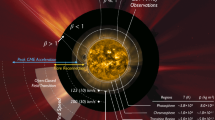Abstract
The volume of observational information on asteroids and trans-Neptunians with satellites has significantly increased in recent years. In this paper we study the dependence of asteroid duplicity on the main physical parameters of the primary: the size and rotation rate. The proportion of binary asteroids is shown to grow rapidly with the rotation rate of the primary. The pattern of dependence between asteroid duplicity and size is more complex, with peaks in the area of small (<10 km) and large (>100 km) bodies. Noteworthy is the small number of binaries among typical-sized asteroids (10–150 km). All the orbits of asteroidal satellites whose rotation direction is known are shown to be prograde and have small eccentricities and inclinations.
Similar content being viewed by others
References
Fridman, A.M. and Gorkavyi, N.N., Physics of Planetary Rings, Springer, 1999.
Gaftonyuk, N. and Gorkavyi, N., The Origin and Rotation of Binary Asteroids, Proc. Conf. “Astronomy in Ukraine—Past, Present and Future” Kiev, July 15–17, 2004, p. 201.
Gaftonyuk, N.M. and Gorkavyi, N.N., The Origin and Rotation of Binary Asteroids, Kinemat. Fiz. Nebesn. Tel. Suppl. Ser., 2005, no. 5, pp. 483–486.
Gorkavyi, N.N., Ozernoy, L.M., Mather, J.C., and Taidakova, T., The NGST and the Zodiacal Light in the Solar System, in NGST Science and Technology Exposition, Smith, E.P. and Long, K.S., Eds., 2000, vol. 207, pp. 462–467.
Gorkavyi, N.N., The New Model of the Origin of the Moon, Bull. Am. Astron. Soc., 2004, vol. 36, p. 861.
Gorkavyi, N.N., Moon and Double Asteroids Formation, Izv. Krymsk. Astrofiz. Obs., 2007, vol. 103, no. 2, pp. 143–155.
Harris, A.W., The Rotation Rates of Very Small Asteroids: Evidence for “Rubble Pileai]” Structure, Proc. 27th Lunar and Planet. Sci. Conf., Houston: Lunar and Planetary Institute, 1996, pp. 493–494.
Johnston, Wm.R., Asteroids and Satellites. http://www.johnstonsarchive.net/astro/asteroidmoons.html
Jones, J.H. and Palme, H., Geochemical Constraints on the Origin of the Earth and Moon, in Origin of the Earth and Moon, Canup, R.M. and Righter, K., Eds., Univ. Arizona Press, 2000, pp. 197–216.
Origin of the Moon, Hartmann, W.K., Phillips, R.J., and Taylor, G.J., Eds., Houston: LPI Press, 1986.
Pravec, P., Harris, A., and Michajlovsky, T., Asteroid Rotation, in Asteroids III, Bottke, W.F., Cellino, A., Paolicchi, P., and Binzel, R.P., Eds., Tuscon: Univ. Arizona Press, 2002, pp. 113–121.
Pravec, P. and Harris, A.W., Binary Asteroid Population. 1. Angular Momentum Content, Icarus, 2007, vol. 190, pp. 250–259.
Ruskol, E.L., Proiskhozhdenie Luny (Origin of the Moon), Moscow: Nauka, 1975.
Warner, B.D., Harris, A.W., and Pravec, P., MPC: The Asteroid Lightcurve Data Base (LCDB), Icarus, 2009, vol. 202, pp. 134–146.
Author information
Authors and Affiliations
Additional information
Original Russian Text © N.M. Gaftonyuk, N.N. Gorkavyi, 2013, published in Astronomicheskii Vestnik, 2013, Vol. 47, No. 3, pp. 213–219.
Rights and permissions
About this article
Cite this article
Gaftonyuk, N.M., Gorkavyi, N.N. Asteroids with satellites: Analysis of observational data. Sol Syst Res 47, 196–202 (2013). https://doi.org/10.1134/S0038094613020032
Received:
Published:
Issue Date:
DOI: https://doi.org/10.1134/S0038094613020032




